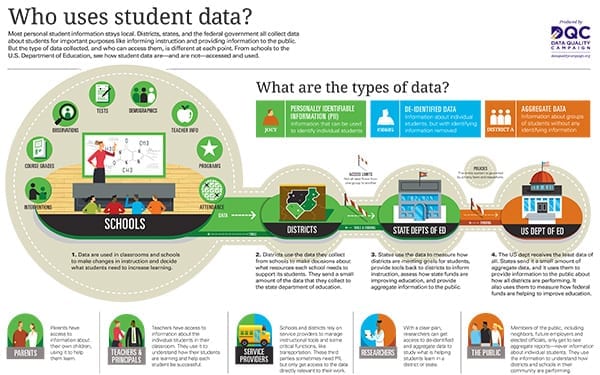Recently, I was having a conversation with a group of friends. One of them broke the big news – she had just registered her daughter for Kindergarten. Certainly a milestone in a parent’s life. “Kindergarten!” “Wow” “Congrats!”
And right on cue, a friend said (jokingly) “Oh no! She is in the system.”
We laughed and joked how life was about to change for this soon-to-be kindergartner. But the thought lingered in my mind. What exactly does it mean to be in “the education system”?
There is much talk about the collection of student data, how it relates to privacy, and sharing data with third party vendors. The conversations also veer into discussions of government overreach in collecting student data for state databases. And while I understand these concerns, the fact is schools collect a tremendous amount of information about students today. Some of the information collected goes into state databases called State Longitudinal Data Systems (SLDS). The purpose of the SLDSs is to enhance the states’ ability to efficiently analyze education data and help make data driven decisions to improve student achievement as well as to facilitate research to direct resources where needed.
The SLDS program was created through the Education Sciences Reform Act (ESRA) in 2002. In order to support this (expensive) undertaking, the federal government has been awarding grants to states since 2005. By 2012 every state had an SLDS in place.
So what can be done with all this data? On a large scale, the data collected can help analyze chronic absenteeism or drop out rates, for example. It also helps schools and districts in their day-to-day operations. The Data Quality Campaign has a great info graphic illustrating the various ways data is used.
 And while I don’t believe in collecting as much data as possible about my children, I do believe in maximizing the valuable information contained in these databases. This information can help states identify and address issues of equity and channel much needed resources into underserved schools. Big data sets can tell important stories. It would be interesting to look at which stories states focus on and which they choose to ignore. We know from previous decades that children who have breakfast do better in school, and so we have programs in place to provide that meal for children who won’t otherwise get it. And a recent Civil Rights Data Collection study (CRDC) from the 2011-12 school year showed racial disparities in discipline in the early years of schooling. This information identifies gaps and allows schools and districts to address discrimination issues and ensure equal access to education. What other causes and effects are waiting to be identified, now that we have the ability to evaluate some of these questions?
And while I don’t believe in collecting as much data as possible about my children, I do believe in maximizing the valuable information contained in these databases. This information can help states identify and address issues of equity and channel much needed resources into underserved schools. Big data sets can tell important stories. It would be interesting to look at which stories states focus on and which they choose to ignore. We know from previous decades that children who have breakfast do better in school, and so we have programs in place to provide that meal for children who won’t otherwise get it. And a recent Civil Rights Data Collection study (CRDC) from the 2011-12 school year showed racial disparities in discipline in the early years of schooling. This information identifies gaps and allows schools and districts to address discrimination issues and ensure equal access to education. What other causes and effects are waiting to be identified, now that we have the ability to evaluate some of these questions?
What I find especially interesting is how information contained in an SLDS is potentially useful to students and parents directly. How can we take this information and put it in the hands of students so they can make decisions about their education? We should seek ways to let students decide “what works” and provide mediums for them to be active participants in “the system.” Students should be empowered to tell their own educational stories; after all they are the main characters.
I recognize any collection of data poses some risk to student privacy. But without data we cannot make informed decisions. It is important for policymakers to erect safeguards so that student data is used responsibly. As data collection continues, we must weigh the privacy risks against the benefits of data analysis but the benefits of having the information can yield great results for students. It is essential that parents see tangible results of the progress that has been made in answering the questions we have using SLDS data. Parents must be able to trust that their children’s data is secure and being managed responsibly, much as we rely on our banks to handle our electronic finances. The more trust parents have in the way their children’s data is used, the better the opportunity for collaboration that will improve educational outcomes.
There is no question that the topic of student data collection and privacy is personal and emotional, but we must deal with specifics and be correct about the facts. There is great potential for student empowerment in enabling students and their parents to be advocates and owners of their learning. We have the data, let’s use it effectively and responsibly.


